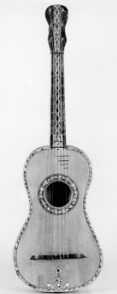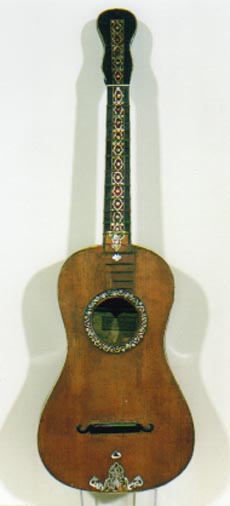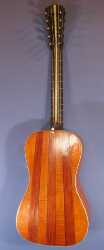
 |
The best information I found regarding the evolution of the modern guitar is the 2002 (or later) revision of "The Guitar And Its Music - From the Renaissance to the Classical Era by James Tyler and Paul Sparks" available from Los Angeles Classical Guitars and other places. It's an expensive book, but it contains vast research and is packed with detailed information. It is a serious academic work which provides new, primary source information and dispels many myths about the guitar. Two-thirds of the book is an update of an earlier book, "The Early Guitar" which details the 4-course and 5-course guitar, as well as some discussion of the vihuela and lute. This background is necessary to understand how the 6-string guitar arose. The latter third of the book is by Paul Sparks, titled "The Origins of the Classical Guitar" which specifically details the invention and evolution of the 6-string modern guitar from 1750-1800. "Additional research of the guitar's history from the 1750's to 1800's examines how the five-course guitar gradually gave way to the six-string instrument, a fascinating process that occurred in different ways and times in France, Italy, Spain, Germany and Britain. - LACG." |
 France 1789 |
 Italy 1792 |
The body shape of these late 18th century 1789 and 1792 guitars look nearly identical to the older Baroque guitars. They are, however, modern 6-string guitars. These guitars are in the French museum Musee de la Musique, and we can be relatively certain of their authenticity. The body shape is typical of the late 18th century, and the frets are on the soundboard like Baroque guitars and Lutes. The labels read "Renault et Châtelain, Paris, 1789" and "Gioacchino Trotto fecit Anno 1792 accofto le grade di S. Demetrio". |
 |
Various guitar method books and publications in the second half of the 18th century debate whether the guitar should be strung as single or double course. Many 5-course instruments were converted by replacing the nut and modifying the bridge for 6-single strings. Only the first 6 peg slots were used for single stringing practice, out of 10 total peg slots (for 5 double strings), as shown in this instrument by Aubert, which was modified in the 18th or 19th century. Many instruments, originally built as 5-course double string guitars, later had their headstock replaced. Presumably, when the 6-course instrument displaced the 5-course guitar in popularity around 1800-1825, many 5-course instruments were still around and could be had cheaply. It was much less expensive in the early 19th century to buy a used 5-course instrument and modify it for 6-single strings, than to purchase a new instrument, and for that reason, many modified Baroque guitars exist. Today, this is viewed as regrettable because an original 5-course Baroque guitar is much more valuable than an altered instrument. |
 |
 |
 |
Double-Course Ancestors:
1687 5-double-course guitar
1750 ca. 5-double-course guitar (right, Clive Titmuss replica Six-course guitar after Benito Sanchez de Aguilera, Madrid 1797) |
 |
 |
 |
Early Romantic Guitars 1794 Fabricatore 6-string (left) 1797 Fabricatore 6-string (right) 1799 Fabricatore 6-string (middle)
|
 |
 |
 |
 |
The 5-double course guitars, left, have the same body shape as early 6-string guitars depicted above, including the 1700 Stradivarius. A "course" is another word for a string - previously, guitars had each string doubled up, e.g. "double course". A modern "12 string" acoustic guitar is really a double-course 6-string guitar. Double-courses give a fuller and louder sound to chords, but they present tuning difficulties and rapid passages are more difficult. For a long time, guitars had 5 strings, doubled up either in unison or octaves. Around the 1750's, a sixth string was added. There is debate over if a single-course 5-string guitar ever existed, or if the extant example was later modified, while it was common to leave half the string slots empty. The oldest single course 6-string guitars bear a striking resemblance to the earlier Baroque 5-string usually double-course guitar, being more elongated with less-prounounced upper and lower bouts. |
| 5-String Guitar Double Course |
Aubert Troyes (France) circa 1770 |
Aubert (back) Photos Courtesy Sinier de Ridder |
Stradivarius Italy 1700 |
 |
The 1700 Stradivarius is the famous guitar made by the world's most famous violin maker! Note the striped back of the neck, the body shape, and the tie bridge. |
 |
The 6-double-course Madrid 1797 guitar replica built by Clive Titmuss shown is a good example of the 6 double-course or 12-string Spanish guitar which was popular from 1750-1830. The double-courses were a common feature of the early Spanish school. This is the style of guitar for which Boccherini composed. Regarding the double-course six-string featured in the pictures above, Clive goes on to say: "It also seems that we are very much ignorant about the music played on these guitars, since only a few sources mention six courses, pricipally Ferandiere and Moretti. The conventional reasoning has it that the guitar went from being an "art music" instrument, played by cultivated and wealthy amateurs and professionals, to being more of a "pop music" instrument, for which the opportunity to print and distribute music was slim. Nevertheless, both of the above composers are important enough to make the instrument interesting. I found it wonderful to play and full of surprises when playing music I normally play on the modern guitar, or did as a student, usually the sonatas of Scarlatti and his school. Many of these pieces, such as those of the Portuguese Seixas, or of Soler and Mateo Albeniz, derive much of thier texture and rhythm from the guitar music of the streets, which the composers have drawn into the typical Neapolitan binary sonata form. There is also a substantial repertoire for harp and for dulcimer, in both printed and MS form. Untravelled territory. " |
 Pons 1804-5 |
 Anon. ca. 1830 |
French Lyre Guitars: 1804-5 (Pons) 1830 (Anon.) Current research shows that at least in France, the Lyre guitar with 6 single strings of which the 3 bass strings were metal wound and top 3 plain gut, and 12 metal frets, appeared before the 6-string guitar. The Lyre guitar was a prime factor in the adoption of the guitar with the same configuration (6 single strings, bottom 3 basses metal wound, 12 or more metal frets). It was called the "New Lyre" because it was based on the ancient Greek lyre shape, as it was fashionable classicism. An illustration in Tyler & Sparks by Lemoine (Paris, 1810) shows hand position for the lyre guitar; this illustration from 1810 reads "Nouvelle lyre invente, et excute par Pons fils, Facteur de Instruments a Paris" - translated "New Lyre invented and made by Pons, Maker of Instruments in Paris". If this is true, that Pons invented the new lyre, then Pons may have had a significant role in the invention of the modern guitar. Pons was the teacher of Lacote, and Pons guitars were owned by Napoleon's wife and Mauro Giuliani. |
Email Contact
Early Romantic Guitar Home Page
 Mail@EarlyRomanticGuitar.com
Mail@EarlyRomanticGuitar.com